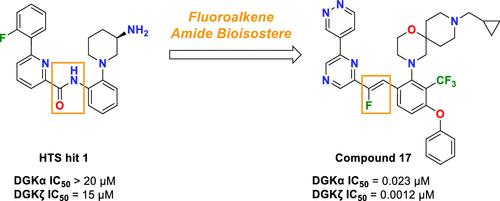氟烯烃作为二酰基甘油激酶α和ζ (DGKα/ζ)双重抑制剂的发现
IF 6.8
1区 医学
Q1 CHEMISTRY, MEDICINAL
引用次数: 0
摘要
二酰基甘油激酶α和ζ (DGKα/ζ)是T细胞受体信号的负调节因子,抑制免疫系统的激活。因此,双重抑制DGKα和ζ代表了一个有希望的策略,以增强抗肿瘤免疫,使这些激酶有吸引力的目标癌症免疫治疗。在这里,我们报告了一系列氟烯烃作为DGKα和ζ的有效双重抑制剂的发现。高通量筛选活动确定酰胺1具有微摩尔活性对DGKζ。虽然SAR研究显示酰胺具有强大的双DGKα/ζ活性,取代酰胺与氟烯烃生物等异体导致细胞活性显著改善。系统的SAR研究导致先导化合物17的发现,这是一种有效的双重DGKα/ζ抑制剂,具有平衡的体外ADME特性和良好的药代动力学特征。在OT-1小鼠药效学模型中证明了化合物17的体内功能活性,在抗原呈递下显示出强大的剂量依赖性免疫激活。本文章由计算机程序翻译,如有差异,请以英文原文为准。

Discovery of Fluoroalkenes as Dual Inhibitors of Diacylglycerol Kinases Alpha and Zeta (DGKα/ζ)
Diacylglycerol kinases alpha and zeta (DGKα/ζ) are negative regulators of T cell receptor signaling that suppress immune system activation. As such, dual inhibition of DGKα and ζ represents a promising strategy to enhance antitumor immunity, making these kinases attractive targets for cancer immunotherapy. Herein, we report the discovery of a series of fluoroalkenes as potent dual inhibitors of DGKα and ζ. A high-throughput screening campaign identified amide 1 with micromolar activity against DGKζ. While SAR studies revealed amides with potent dual DGKα/ζ activity, replacing the amide with a fluoroalkene bioisostere led to a significant improvement in cellular activity. Systematic SAR studies led to the discovery of lead compound 17, a potent dual DGKα/ζ inhibitor with balanced in vitro ADME properties and favorable pharmacokinetic profiles. The in vivo functional activity of compound 17 was demonstrated in an OT-1 pharmacodynamic murine model, showing robust and dose-dependent immune activation in the presence of antigen presentation.
求助全文
通过发布文献求助,成功后即可免费获取论文全文。
去求助
来源期刊

Journal of Medicinal Chemistry
医学-医药化学
CiteScore
4.00
自引率
11.00%
发文量
804
审稿时长
1.9 months
期刊介绍:
The Journal of Medicinal Chemistry is a prestigious biweekly peer-reviewed publication that focuses on the multifaceted field of medicinal chemistry. Since its inception in 1959 as the Journal of Medicinal and Pharmaceutical Chemistry, it has evolved to become a cornerstone in the dissemination of research findings related to the design, synthesis, and development of therapeutic agents.
The Journal of Medicinal Chemistry is recognized for its significant impact in the scientific community, as evidenced by its 2022 impact factor of 7.3. This metric reflects the journal's influence and the importance of its content in shaping the future of drug discovery and development. The journal serves as a vital resource for chemists, pharmacologists, and other researchers interested in the molecular mechanisms of drug action and the optimization of therapeutic compounds.
 求助内容:
求助内容: 应助结果提醒方式:
应助结果提醒方式:


